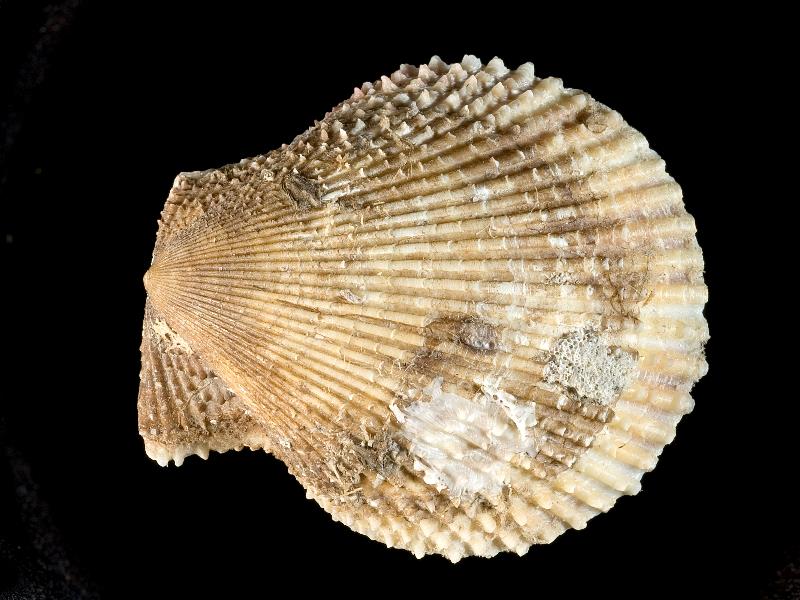Northern Ireland Priority species (NIPS)
| MOLLUSCA : Pectinida : Pectinidae | SNAILS, SLUGS, ETC. |
Mimachlamys varia (Linnaeus, 1758)
 |
| Mimachlamys varia |
This attractive bivalve mollusc is common in the sheltered waters of Northern Ireland, particularly Strangford Lough. It is part of the horse mussel community there, where the population has been damaged in recent years.
In brief
- This species is found frequently in Northern Ireland, but most commonly in Strangford Lough
- It lives on sheltered shores, normally under boulders, often attached by a byssus
- This species has undergone rapid decline
- It is part of the horse mussel community in the sublittoral in Strangford Lough, which has been damaged
- The main threat is the impact of commercial fishing gear.
Species description: The shell is solid, oval and inequilateral. The ears on the valves are unequal, with the anterior being at least twice as long as the posterior, and possessing a distinct rounded byssal notch. The shell sculpture is of 25-35 bold ribs and a few corrugrated concentric lines raised into spatulate spines along the ribs. The margin of the shell is strongly crenulate where it is met by the ribs. It shows very variable colouration, being off-white, yellow, pink, orange, brick-red, purple, greenish-brown or brown, often with bands or patches of darker or lighter colour. It is normally not longer than 6.5cm.
Life cycle: The variegated scallop matures as a male, but changes sex several times during its life. It is attached by the threads of a byssus when young, but may become free later – it often grows enclosed by algal holdfasts.
Similar species: There are several similar species: Chlamys distorta; Palliolum tigerinum; Palliolum striatum and Aequipecten opercularis. Chlamys distorta is distinguished by both shell valves being irregular or distorted and the strongly convex right valve is usually cemented to the substratum in adults. The radiating ribs alternate with an irregular width. Palliolum spp. have a sculpture of fine radiating lines, rather than raised ribs. The valves for Aequipecten opercularis have equally-sized ears.
How to see this species: The variegated scallop is common around the low zone of the shores of Strangford Lough, except for the muddiest areas, but also in the sublittoral to 42m+. It is rare outside the lough, with scattered records off Ards and south Down, Rathlin Island, Dundrum Bay, Carlingford Lough, Skerries and Murlough Bay, all in the sublittoral. This species cannot inhabit wave-exposed areas. It is present at all times of the year. It lives either free or attached by a byssus, often associated with kelp holdfasts, but normally under or on boulders. It has a close association with sponges which often cover the shell, such as Halichondria panicea. This relationship is described as commensal-protective mutualism.
Current status: This species is common only in Northern Ireland from Strangford Lough. This species is not threatened as part of lower shore populations. However, it is associated with the horse mussel Modiolus modiolus community particularly in the mid and north of Strangford Lough. This community has been severely damaged. The horse mussel community of which it is a significant part in Strangford Lough, has been heavily affected by fishing gear, causing a rapid decline in that habitat. Elsewhere, the species is common all round the island of Ireland except for the south coast, and off all British coasts from the lower shore to about 100m. It is found from Denmark to the Iberian Peninsula; Mediterranean, and off the coast of West Africa.
Why is this species a priority in Northern Ireland?
- This species has undergone rapid decline.
Threats: The major threat to the variegated scallop is the impact of commercial fishing gear on the horse mussel/variegated scallop community in Strangford Lough.
Distribution Map from NBN: Mimachlamys varia at National Biodiversity Network mapping facility, data for UK.
iNaturalist: Mimachlamys varia at iNaturalist World Species Observations database.
WoRMS: Mimachlamys varia at World Register of Marine Species. Accepted name: Mimachlamys varia (Linnaeus, 1758). AphiaID: 236719.
Classification: Biota; Animalia; Mollusca; Bivalvia; Autobranchia; Pteriomorphia; Pectinida; Pectinoidea; Pectinidae; Pedinae; Mimachlamydini; Mimachlamys
| Previous species | Next species |
| Authors (2024). Mimachlamys varia. (Linnaeus, 1758). [In] Priority species, Marine Biodiversity Portal NI. https://www2.habitas.org.uk/marbiop-ni/priorityaccounts.php?item=W18000. Accessed on 2025-04-19 |